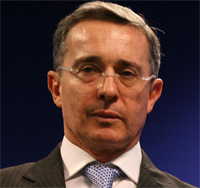Colombia’s unethical development
Development can be carried out with justice, respect and dignity for the poor. Or with violence, displacement and the suppression of human rights. Colombia’s former president chose the latter
Alvaro Uribe Vélez, Colombia’s president between 2002 and 2010, is as divisive a figure as his neighbour and long-time phoney-war sparring partner, Hugo Chávez. Lauded by the right for saving the country from the brink of despair (Farc guerrillas had famously arrived at the outskirts of the capital Bogotá) and loathed on the left for his dismal record on human rights, his world lecture tour has followed a predictable pattern – he speaks at business school receptions while protesters scream at him from the pavements.
For most of the decade, Uribe led the only country in South America, with the possible exception of Peru, that followed an orthodox neoliberal approach to economics and wanted no part of the anti-imperialist sentiment that swept most of the new left to power, maintaining exceptionally tight political links with the US.
So how did Colombia fare under Uribe in terms of poverty reduction and development? The answer gives us a clue to the main battlegrounds in international development in the 21st century.
Development is essentially amoral. This may come as a shock to some people who think the concept implies a moral cause. I have spoken to rural community representatives in Colombia who say “development” is a threat to their families and way of life.
Why? Because although development can mean jobs, poverty reduction, greater respect for human rights, better access to basic services, and greater land sovereignty, it doesn’t necessarily. Believe it or not, it is possible to reduce income poverty (MDG1), and to meet a range of other MDGs regarding provision of basic health and education while simultaneously committing grave human rights abuses, disempowering the poorest, and encouraging the consolidation of power and wealth in the hands of the rich.
Imagine a situation in which millions of people are displaced from their land by violence or the threat of violence. The land is taken over by businesses that develop mega plantations to produce bananas, palm oil, or, yes, coca. Jungle is cleared for cattle rearing. Mines are dug to extract copper, gold, emeralds or oil. The manufacturing sector, which creates jobs and strengthens the middle class, fails to advance while resource extraction and export, which employs very few and fills the pockets of the wealthy, is the key plank of development strategy.
Private investment flows in, which some analysts think is vital for development. Exports lead to economic growth, which many commentators seem to think is synonymous with development. Meanwhile, as human rights are ignored in order to quell social conflict, claims are made that the state finally controls its territory. An ex-president begins a world tour to explain how he did it.
So what happens to the displaced rural communities? Some are wiped out, especially the indigenous groups, who slowly become extinct. Others go to towns and cities, where they have no cultural or political identity, and may live in misery or are dependent on others. Ironically, they often have better access to basic healthcare and education, which are more prevalent in urban areas. And their incomes may increase, as they join the labour market rather than depend on the land. Of course, as the cost of living is higher, they are in truth poorer – but the statistics that make up MDG1 look rosy.
Crucially, the children of internally displaced people, like the children of refugees, may do much better than their parents. In a sense, then, development is taking place, because the next generation is better off according to basic development indicators.
The model of development I’m sketching here is, in my view, the one Uribe chose, and which his successor, Juan Manuel Santos, is continuing. It is a caricature, of course, and the reality is far more complicated. For example, the urban security achieved by Uribe has indeed led to increased investment and tourism, which is important. A balanced assessment of his time in office needs to acknowledge some steps forward.
But Colombia is fundamentally an example of how development can be unethical. Millions have been displaced, thousands killed, tribes wiped out, all in the name of development. Development can be carried out with justice, respect and dignity for the poor. Or it can be carried out with violence, displacement and the suppression of human rights. Development indicators can be met with a focus on jobs and equality or, bypassing these, with patriarchal handouts and the delivery of basic services without affecting fundamental power relations.
Colombia may be one of the best examples of the complexities and contradictions of development in the modern world, but it is far from alone. Speak to the Arabs rising up against their governments. Look at Rwanda and Ethiopia, Sri Lanka and Burma. The land grabs common in the new scramble for Africa are often no different from the kinds of practice I have described above. Some talk of a trade-off between human rights and development. But, in reality, the development strategy pursued by a particular government is a matter of moral and political choice.
While the world has devised development targets to chart progress, it has not yet built a database to measure the costs. The idea of the costs of development sounds like an oxymoron, but is the fundamental concept we need to place at the heart of development theory and practice in the 21st century. We need ethical, not just sustainable, development. As for Colombia, if this is the route to development, I’m handing back my ticket.
• This article was amended on 6 June 2011: the word ‘amoral’ was in the original article and headline, this has now been changed.
http://www.guardian.co.uk/global-development/poverty-matters/2011/jun/06/colombia-amoral-development-uribe

